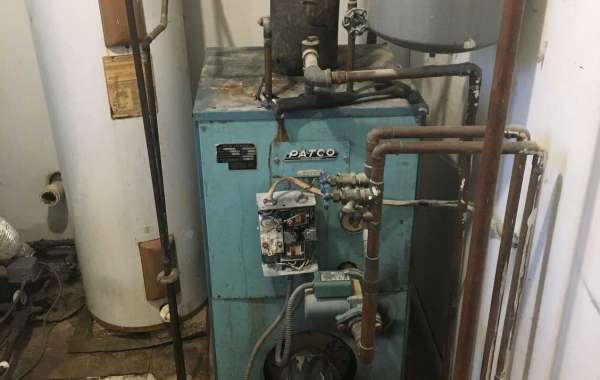If your home’s heating system uses a boiler with a tankless coil to provide hot water, you may notice a gradual decline in water temperature, longer heat-up times, or higher energy bills. These are signs that it may be time to replace your tankless coil.
Replacing this component can help improve energy efficiency, reduce heating costs, and provide reliable hot water flow when you need it.
This guide will explain what a tankless coil is, signs it’s time for a replacement, and how a new coil can optimize your boiler’s performance.
What is a Tankless Coil in a Boiler?
A tankless coil is a heat exchanger located inside a boiler. It heats water on demand by transferring heat from the boiler’s hot water to the water supply, eliminating the need for a separate water heater.
Because water is heated only when needed, tankless coils are commonly used in homes with limited space and moderate hot water demands. However, over time, these coils can become inefficient due to mineral deposits, corrosion, and general wear and tear.
Why Replace the Tankless Coil?
While a tankless coil provides a space-efficient way to heat water, it can lose efficiency over time. The primary reasons for this include:
Mineral Buildup: Hard water can lead to mineral deposits, especially calcium, on the coil’s surface. This buildup reduces heat transfer efficiency, making it harder for the boiler to heat water effectively.
Corrosion and Wear: Over years of use, the coil is exposed to water and temperature fluctuations, which can lead to rust and wear. This compromises the coil’s effectiveness and lifespan.
Reduced Hot Water Output: An aging or damaged coil will struggle to produce hot water on demand, leading to colder water temperatures or inconsistent water heating.
Increased Energy Consumption: As efficiency declines, the boiler must work harder to reach the desired water temperature, leading to higher fuel or electricity consumption and increased energy bills.
Signs It’s Time to Replace Your Tankless Coil
Before experiencing a total loss of hot water, certain signs may indicate that your tankless coil is reaching the end of its life:
Decreased Water Temperature: If hot water is noticeably cooler than it used to be, this may be due to reduced heat transfer from the coil.
Longer Wait Times for Hot Water: A well-functioning coil heats water quickly. If there’s a delay in hot water delivery, it may be time to inspect the coil.
Higher Energy Bills: If your energy bills are climbing without an increase in usage, an inefficient coil could be causing the boiler to use more fuel or electricity to meet demand.
Scaling and Corrosion: Visible scaling on the coil or signs of rust could indicate the coil is worn out and needs replacement.
Steps to Replace a Tankless Coil
Replacing a tankless coil involves several steps that require technical knowledge of boiler systems. While hiring a professional is recommended, understanding the process can help you make informed decisions. Here’s an overview:
Turn Off the Boiler: Always start by powering down the boiler and allowing it to cool. Turn off the water supply and bleed any remaining pressure from the system.
Drain the Boiler: Remove any water inside the boiler to prevent leaks and make the coil accessible.
Disconnect the Coil: Carefully disconnect the pipes leading to the tankless coil. You’ll typically need a wrench to loosen connections without damaging pipes or fittings.
Remove the Coil: Unscrew and remove the coil from the boiler. This step requires caution to avoid damaging the mounting and surrounding components.
Clean and Inspect: Before installing a new coil, clean the area and inspect for any signs of rust, damage, or wear that may need attention.
Install the New Coil: Position the replacement coil carefully and secure it in place. Ensure it fits snugly and aligns with the mounting and pipe connections.
Reconnect Pipes and Test: Once the new coil is installed, reconnect the pipes and check for leaks. Turn on the water supply and test the system to ensure it’s heating water efficiently.
Benefits of Replacing the Tankless Coil
Investing in a new tankless coil can lead to several improvements in both performance and efficiency:
Improved Hot Water Output: A fresh coil delivers more consistent hot water, minimizing temperature fluctuations and ensuring comfort.
Enhanced Energy Efficiency: A clean, corrosion-free coil optimizes heat transfer, allowing your boiler to operate more efficiently and reduce energy costs.
Extended Boiler Life: By preventing the boiler from overworking to compensate for an inefficient coil, you reduce wear on the system, potentially extending its life.
Reduced Maintenance Costs: A new coil reduces the need for frequent repairs and maintenance, saving you money over time.
Maintaining Your New Tankless Coil
Once the new coil is installed, regular maintenance can keep it running efficiently:
Descale Annually: Hard water deposits can accumulate quickly, especially in regions with high mineral content. Regular descaling helps maintain heat transfer efficiency.
Check for Leaks and Corrosion: Inspect the coil connections periodically to catch any signs of leaks or rust, which can prevent costly repairs down the line.
Monitor Water Temperature: If you notice any decline in water temperature or delay in heating, inspect the coil or contact a technician to avoid potential issues.
Replacing an aging or inefficient tankless coil in your boiler can significantly improve both water heating efficiency and overall boiler performance. With a more efficient coil, you’ll benefit from consistent hot water, lower energy costs, and a more reliable heating system.
Routine maintenance will ensure your new coil continues to perform well, providing hot water when you need it without the extra expense or hassle.







